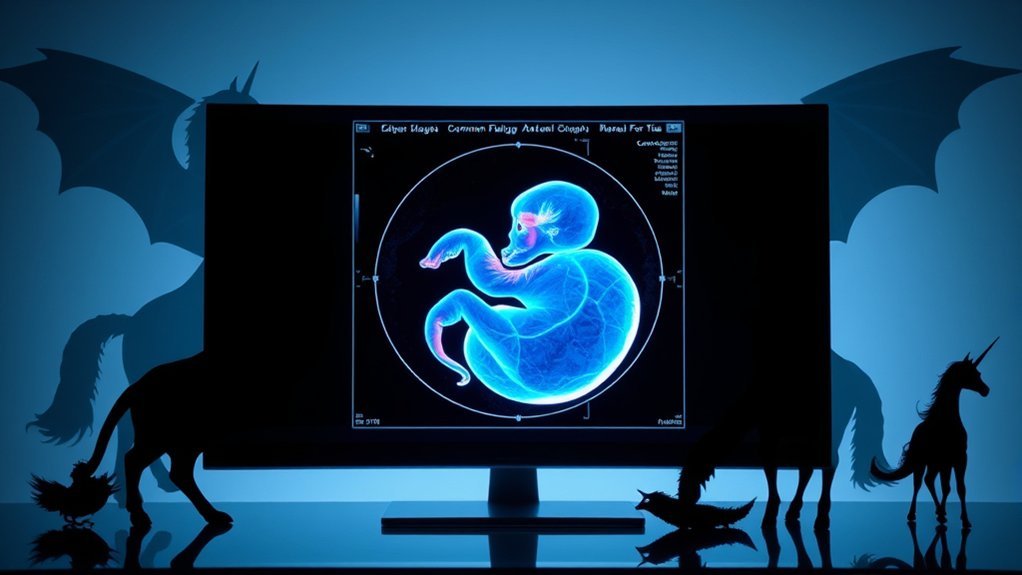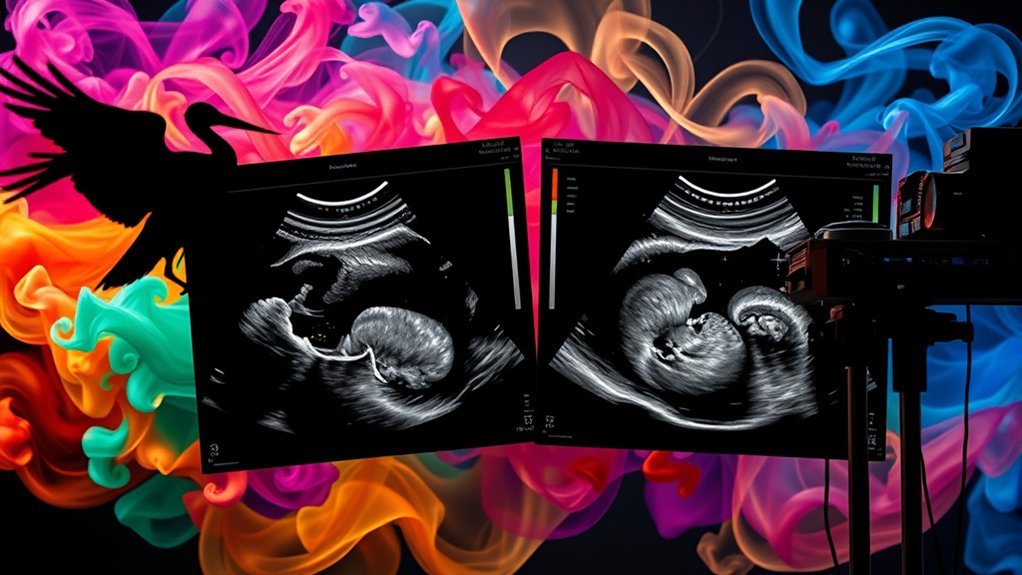An anatomy scan is like peering through a window into your baby’s world, revealing vital details about their development. However, many myths surround these scans, leading to confusion among expectant parents. From gender prediction to safety concerns, understanding the facts is imperative. What you learn can greatly impact your journey, but misconceptions can cloud your judgment. Let’s separate the myths from the facts to guarantee you’re fully informed.
Understanding the Purpose of an Anatomy Scan

When you’re expecting a baby, understanding the purpose of an anatomy scan is fundamental for your journey. This ultrasound, typically performed around 18 to 20 weeks, provides essential insights into your baby’s development.
It helps identify the baby’s anatomy, including the heart, brain, and limbs, ensuring everything is progressing normally. You’ll also get to see your baby in greater detail, which can be an exciting moment.
Beyond monitoring growth, the anatomy scan can detect potential abnormalities early, allowing for better planning and decision-making. Additionally, it’s an opportunity to check the placenta’s position and amniotic fluid levels.
Common Myths About What Can Be Seen

You might believe that an anatomy scan can reliably predict your baby’s gender, but that’s not always the case.
Additionally, while the scan can show organ development, it’s not a complete diagnostic tool for all issues.
Understanding these myths can help set realistic expectations for your scan results.
Gender Prediction Accuracy
Although many expect the anatomy scan to provide a definitive answer about their baby’s gender, the reality is often more nuanced.
While the scan can give you a good indication, it’s not always 100% accurate. Factors like the baby’s position, the technician’s experience, and the clarity of the images can all influence the results.
Some common myths suggest that certain physical traits or the shape of your belly can predict gender, but these are largely unfounded.
It’s important to remember that while the scan can offer a glimpse into your baby’s gender, surprises can still happen. If you’re impatient to know, be prepared for the possibility that the information may change as your pregnancy progresses.
Organ Development Visualization
While many parents look forward to the anatomy scan for gender prediction, it also serves an important purpose in evaluating the development of various organs.
You might believe that you can see everything during the scan, but that’s a common misconception. Here’s what you can realistically expect:
- Heart: You’ll see the heart beating and assess its structure, but not every detail is visible.
- Brain: The tech can check basic brain structures, but finer details may not be captured.
- Kidneys: Kidney development is usually visible, but function and potential issues can’t always be determined.
Understanding these limitations helps set realistic expectations for this crucial assessment of your baby’s health.
The Timing of Anatomy Scans: When Is the Best Time?

When’s the ideal time for an anatomy scan? Most healthcare providers recommend scheduling your anatomy scan between 18 to 20 weeks of pregnancy.
The ideal time for an anatomy scan is between 18 to 20 weeks of pregnancy, according to most healthcare providers.
At this stage, your baby’s organs are developed enough to be clearly visualized, allowing for a thorough assessment of their health and growth. This timeframe also enables you to gather important information, like the baby’s sex, if you wish to know.
Waiting until this period guarantees that the ultrasound can provide accurate measurements and detect potential abnormalities effectively.
Keep in mind, though, that timing may vary based on your individual circumstances or healthcare provider’s recommendations. Always consult with your doctor to determine the best schedule for your anatomy scan, ensuring you get the most benefit from this important check-up.
Safety Concerns: Are Anatomy Scans Harmful?
When considering anatomy scans, you might worry about safety concerns, especially regarding radiation exposure.
Fortunately, ultrasound technology has been shown to be safe for both you and your baby.
Let’s explore what the evidence says about the risks and benefits of these scans.
Radiation Exposure Risks
Although you might’ve concerns about radiation exposure during an anatomy scan, it’s important to understand that these scans, such as ultrasounds, typically don’t use harmful radiation.
Here are some key points to take into account:
- Types of Scans: Most anatomy scans, especially ultrasounds, use sound waves, not radiation, to create images.
- Radiation Risks: When scans do involve radiation, like X-rays, the exposure is minimal and carefully monitored to guarantee safety.
- Benefits vs. Risks: The benefits of obtaining critical information about your health usually outweigh any minimal risks associated with radiation.
Ultrasound Safety Evidence
While concerns about radiation exposure are valid, understanding the safety evidence surrounding ultrasounds can help ease any worries about anatomy scans.
Ultrasounds use sound waves, not radiation, making them a safe option for monitoring your baby’s development. Research has consistently shown that diagnostic ultrasounds pose no known risk to you or your fetus when performed by trained professionals.
The American College of Obstetricians and Gynecologists supports this, stating that ultrasounds are a routine and safe procedure. However, it’s crucial to verify that ultrasounds are conducted only when medically necessary.
Avoid non-medical uses, like keepsake ultrasounds, as they may not prioritize safety. To conclude, ultrasounds are a reliable tool for monitoring pregnancy, with a strong safety record.
The Role of Technology in Anatomy Scans
As technology continues to evolve, its impact on anatomy scans has become increasingly significant. You might be surprised by how advancements enhance the accuracy and effectiveness of these scans.
Here are three key roles technology plays:
- Improved Imaging Quality: High-resolution ultrasound machines provide clearer images, allowing for better visualization of fetal anatomy.
- 3D and 4D Capabilities: These technologies offer dynamic views of the fetus, helping you see real-time movements and more detailed structures.
- Automated Measurements: Advanced software can quickly analyze data, reducing human error and ensuring accurate assessments of fetal growth and development.
With these advancements, you can have greater confidence in the information gathered during your anatomy scan, making the experience more reassuring and informative.
Interpreting the Results: What Parents Should Know
Understanding the results of your anatomy scan can feel overwhelming, especially with all the medical terminology involved. It’s crucial to remember that the scan primarily checks for structural abnormalities and the baby’s growth.
Your healthcare provider will explain findings like the baby’s size, organ development, and any potential concerns. Look for key terms such as “normal,” which indicates everything appears healthy, or “anomaly,” which suggests further evaluation may be needed.
Don’t hesitate to ask questions about anything you don’t understand. Keep in mind that not all findings are alarming; many may resolve on their own.
Finally, trust your instincts—if you feel uncertain, reach out to your provider for clarification and guidance. You’re not alone in this journey.
The Importance of Follow-Up Care After an Anatomy Scan
Many parents underestimate the importance of follow-up care after an anatomy scan. This care is essential for ensuring the health and well-being of both you and your baby. Here’s why you shouldn’t overlook it:
- Addressing Concerns: If there are any abnormalities detected, follow-up appointments help clarify the situation and guide you in making informed decisions.
- Monitoring Development: Regular check-ups allow your healthcare provider to track your baby’s growth and development, ensuring everything’s on track.
- Emotional Support: Follow-up visits provide a space to discuss any fears or anxieties you might have, helping you feel more supported during your pregnancy.
Prioritizing follow-up care can lead to a healthier pregnancy and peace of mind for you and your family.
Frequently Asked Questions
Can Anatomy Scans Determine the Baby’s Gender?
Yes, anatomy scans can often determine your baby’s gender, typically around 18-20 weeks. However, accuracy depends on the baby’s position and the technician’s expertise, so it’s not always 100% reliable.
How Long Does an Anatomy Scan Usually Take?
An anatomy scan usually takes about 30 to 60 minutes. During this time, the technician checks your baby’s development and can provide detailed images, so it’s important to be patient and relaxed throughout the process.
What Should I Wear for the Anatomy Scan?
You should wear comfortable, loose-fitting clothing for the anatomy scan. Opt for a top that allows easy access to your abdomen. Avoid tight belts or layers that could make the process more difficult.
Can I Bring Someone With Me to the Scan?
You can absolutely bring someone with you to the scan! It’s always better to have a buddy by your side for support. Just check with the facility beforehand to confirm they allow extra guests.
Will I Receive a Copy of the Scan Images?
Yes, you’ll typically receive a copy of your scan images. Your healthcare provider will either give you printed images right away or provide digital access through a secure portal after your appointment.
Conclusion
In summary, understanding the facts about anatomy scans can empower you during your pregnancy journey. While myths may swirl around, remember these scans are primarily for evaluating your baby’s health, not just predicting gender. Isn’t it reassuring to know that many concerns can resolve naturally? By staying informed and prioritizing follow-up care, you can guarantee the best outcomes for you and your little one. Embrace this exciting time with knowledge and confidence!
